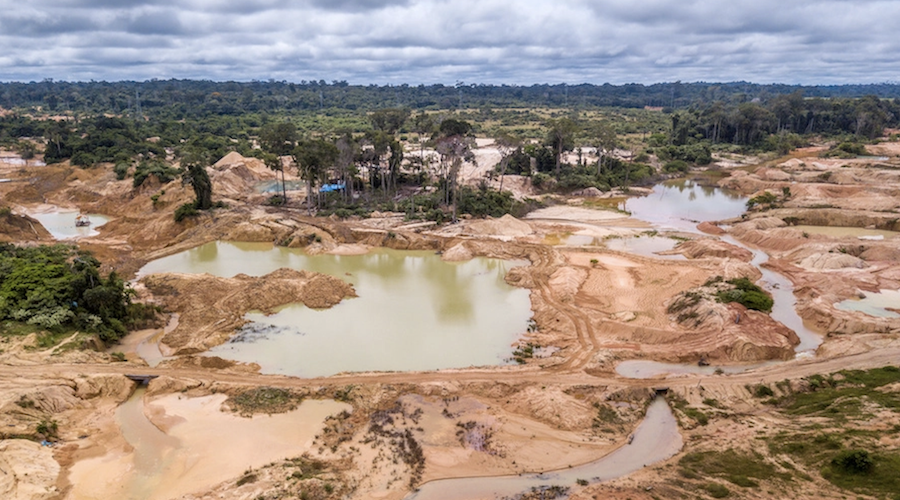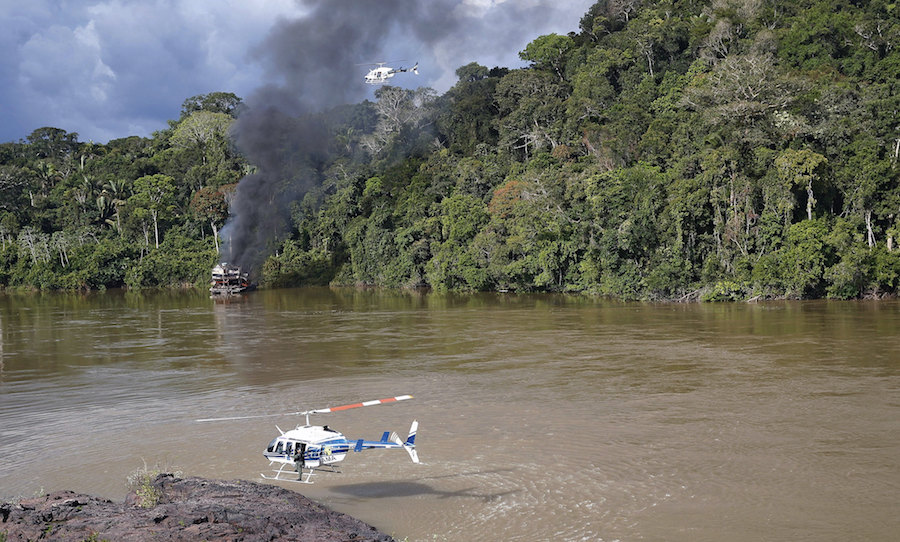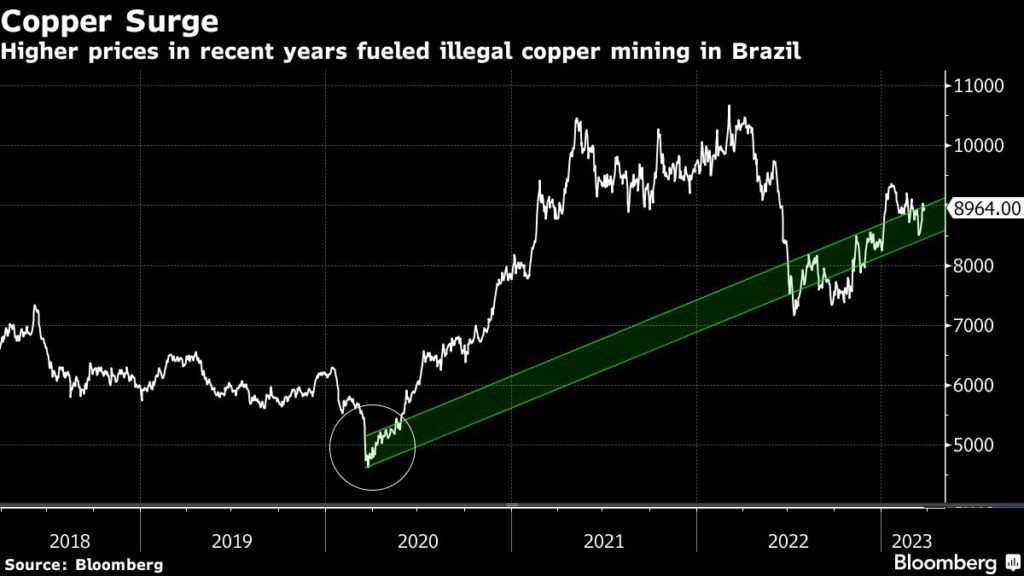Cecilia Jamasmie | March 31, 2023 |

Aerial view of deforested area of the Amazon rainforest caused by illegal mining activities in Brazil. (Image: Imago Photo | Adobe Stock.)
Brazilian gold aggregator Fênix DTVM and Minespider, which runs a traceability platform for tracking down the precious metal through the supply chain, completed this week the first stage of a project that aims to make Brazil’s gold sector transparent.

The two companies have integrated traceability in gold sourcing and processing activities, delivering the first fully traced gold bar to one of Fênix’s clients.
By the end of 2023, Fênix DTVM plans to aggregate 100% traceable gold with the Minespider traceability platform, based on blockchain technology.
The milestone comes as Brazil’s government is increasing efforts to crack down on illegal gold mining in the Amazon, through legislation that would require electronic tax receipts for the buying and selling of the precious metal.
Electronic tax receipts can be an important tool for eradicating illegal mining,” Christian Ecker, Client Partner at Minespider, told MINING.COM.
Currently, gold is sold with paper receipts based on the “good faith” of the seller, making it impossible to trace its origin.
“Paper documents can be more easily faked or edited (…) If done right, electronic receipts can make this harder and thereby reduce gold laundering and smuggling,” Ecker said. “It might also make tax collection more efficient.”
The electronic receipt, or “nota fiscal” in Portuguese, would identify the name and tax number of the seller, the operation where the gold was extracted, as well as the authorization number of the mining license.
Brazilian President Luiz Inacio Lula da Silva is preparing legislation to add transparency to the sector and end deforestation, which surged to a 15-year-high under his far-right predecessor, Jair Bolsonaro.
Lula has also pledged to take better care of indigenous populations in the Amazon who are threatened by armed wildcat miners.

In 2015, an indigenous alliance demanded that Brazil halt Amazon dam construction. (Image courtesy of Amazon Watch.)
According to Instituto Escolha, Brazil exported 229 tonnes of gold with “serious evidence of illegality”, between 2019 and 2022. The figure, the report says, accounts for almost half of all local production.
Mining industry lobby group Ibram’s figures are equally alarming. It claims that close to half of the 100 tonnes of gold Brazil produces each year is thought to be illegally mined and laundered by financial brokerages that are regulated by the central bank.
Fênix DTVM and Minespider Fênix DTVM and Minespider’s solution can be integrated with legacy systems and could, potentially, help the government achieve its objectives.
“This tool enables transparency about gold’s provenance as buyers know where it’s coming from,” Ecker said. “We want to get to a point where this traceability is considered ‘normal’ and buyers expect transparency and are skeptical about non-transparent gold.”
Fênix DTVM and Minespider will expand the use of their platform to all supply chains with the overall goal of having 100% traceability across all suppliers and operations by the end of 2023.
According to Instituto Escolha, Brazil exported 229 tonnes of gold with “serious evidence of illegality”, between 2019 and 2022. The figure, the report says, accounts for almost half of all local production.
Mining industry lobby group Ibram’s figures are equally alarming. It claims that close to half of the 100 tonnes of gold Brazil produces each year is thought to be illegally mined and laundered by financial brokerages that are regulated by the central bank.
Fênix DTVM and Minespider Fênix DTVM and Minespider’s solution can be integrated with legacy systems and could, potentially, help the government achieve its objectives.
“This tool enables transparency about gold’s provenance as buyers know where it’s coming from,” Ecker said. “We want to get to a point where this traceability is considered ‘normal’ and buyers expect transparency and are skeptical about non-transparent gold.”
Fênix DTVM and Minespider will expand the use of their platform to all supply chains with the overall goal of having 100% traceability across all suppliers and operations by the end of 2023.
Illegal Amazon miners are expanding into copper as prices surge
Bloomberg News | March 31, 2023 \

Specialized Inspection Group (GEF) carries out an operation to combat illegal gold mining on the Jamanxim River, in the state of Pará. (Photo Felipe Werneck/Ibama.)
Authorities in Brazil are cracking down on illegal copper mining in the Amazon as high prices of the wiring metal attract black-market operators who normally focus on gold.

Earlier this month, 50 agents dismantled illicit mines in Canaa dos Carajas — near Vale SA’s biggest copper mine, Sossego — after two similar actions last year. There are signs the metal has been shipped to China, task-force leader Ezequias Martins said via his press office. The case may lead to convictions for environmental crimes and criminal association, he said
Unlicensed miners, known in Brazil as garimpeiros, have diversified into copper in recent years as techniques improve and prices surge on growing battery-metal demand in the shift away from fossil fuels. At the same time, major mining companies are looking to add copper assets. Vale wants to raise money to grow its base metals business.
While illegal production accounts for a tiny portion of total copper supply, it can have an outsized impact on the environment and indigenous communities. President Luiz Inacio Lula da Silva’s government has vowed to crack down on Brazil’s illegal gold rush, with non-government organization MapBiomas estimating that irregular operations now occupy a larger area than industrial mines in the country.
The clandestine copper mines demobilized this month are the so-called gallery type, in which explosives are used to blast out ore containing copper and gold. Some galleries can extract 30 tons a day. Copper trades at about $9,000 a ton in London versus less than $5,000 three years ago.
The environmental and community damage caused by such practices are a threat to the formal industry by tarnishing the reputation of mining in general.
Read More: New tool could help Brazil’s crack down on illegal gold mining
The illegal mining push has started to encroach into land held by Vale, the world’s No. 2 iron ore producer and a major supplier of nickel and copper. With illicit miners now hunting for copper, Vale has reinforced monitoring and provides intelligence to regulator ANM on clandestine operations on its land, the company said in response to Bloomberg questions.
“In addition to constituting a crime, the practice imposes drastic impacts on the environment, public coffers, security and the attraction of investments and the implementation of new enterprises,” Vale said.

(By Mariana Durao and James Attwood, with assistance from Joe Deaux)
No comments:
Post a Comment